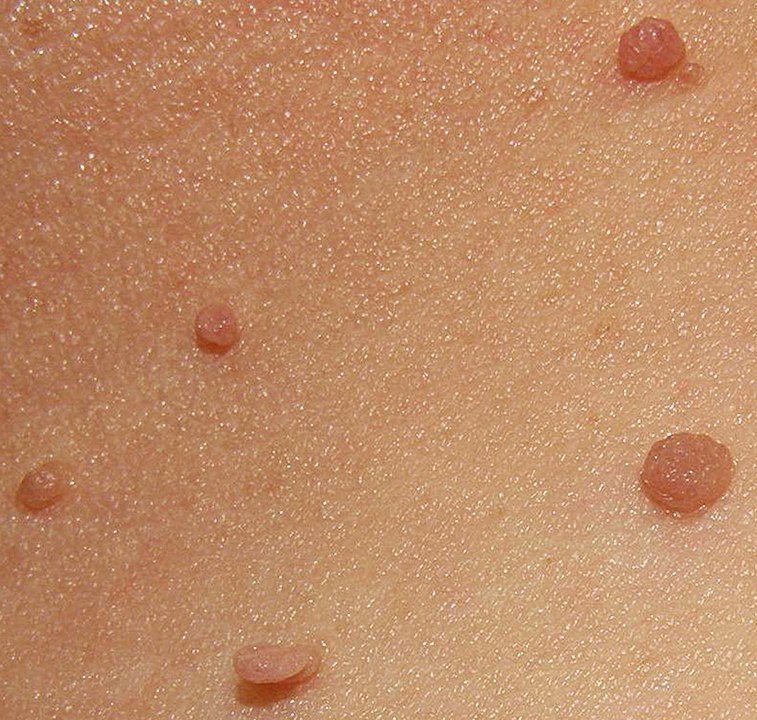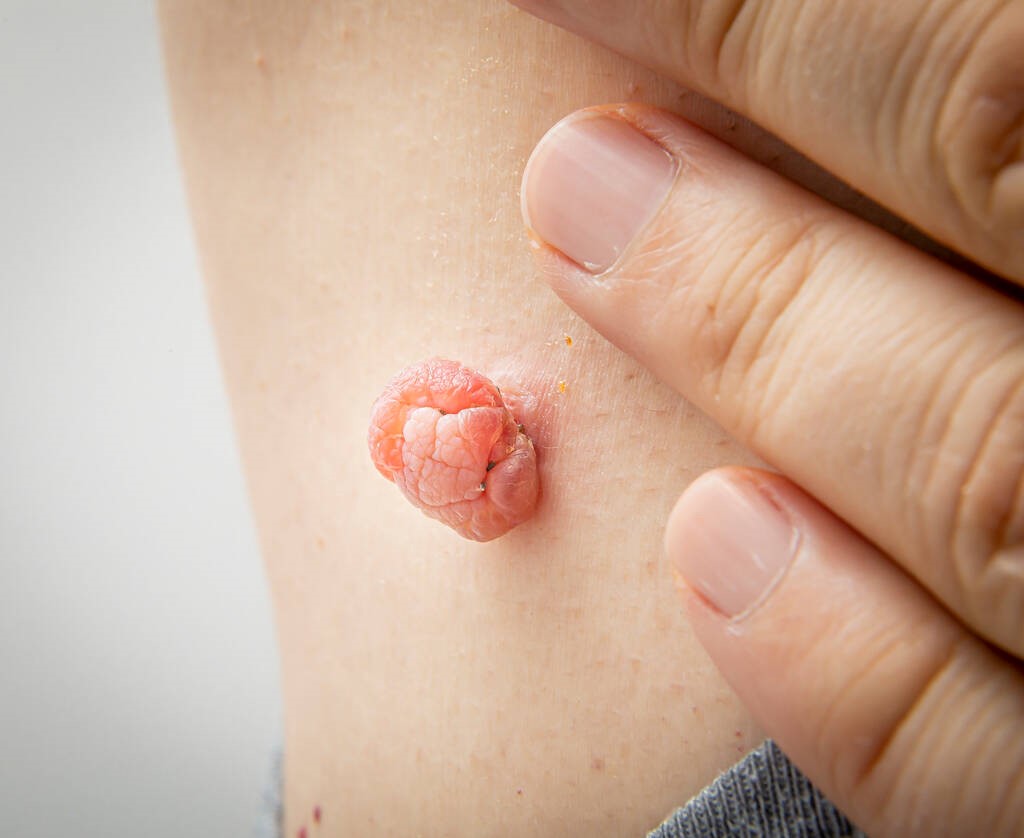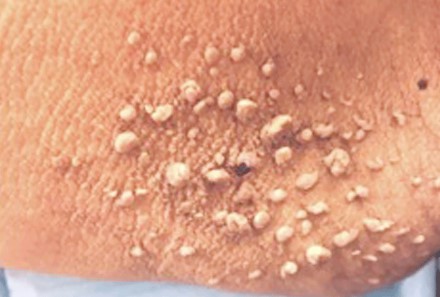Skin Tags
A skin tag is a benign growth that typically forms in areas where the skin rubs together, such as the skin folds of the neck, armpits, groin, breasts, and eyelids. Skin tags are extremely common, especially among older adults, with more than three million cases diagnosed each year in the United States. While skin tags aren’t usually medically necessary to remove, many people choose to remove them for cosmetic reasons or if they become itchy or bothersome. Board-certified cosmetic dermatologist Dr. Michele Green in New York City offers several non-invasive treatment options for skin tag removal that don’t involve any downtime, discomfort, or residual scarring to reveal a clear, smooth complexion.
Electrodesiccation, cryotherapy, and excision are all excellent methods for safely and effectively removing skin tags from the body. Choosing one skin tag removal method over another usually depends on the size and location of the skin growth. Electrodesscation entails using a tiny needle to deliver an electric current to cauterize the skin tag, which eventually scabs up and heals. Smaller skin tags may be treated with cryotherapy, which involves the direct application of liquid nitrogen to freeze the skin tag upon contact with the skin. Larger skin tags with a thicker stalk may be removed with surgical excision, and a biopsy may be sent for histological review to rule out other skin conditions, such as warts or skin cancer. If you are interested in skin tag removal, Dr. Green is here to help.
Dr. Michele Green is an internationally renowned board-certified dermatologist with over 25 years of experience treating some of the world’s most discerning individuals, including skin tag removal. She takes a holistic approach, customizing each patient’s treatment plan to suit their particular skin concerns and address their personal aesthetic goals. She is consistently identified as one of New York City’s best dermatologists by Castle Connolly, New York Magazine, Super Doctors, and The New York Times for her dedication to her patients and expertise. In her private dermatology office in Manhattan’s Upper East Side neighborhood, Dr. Green will work with you to establish a plan for achieving and maintaining healthy, clear, smooth, and beautiful skin.
What are skin tags?
A skin tag, or acrochordon, is a benign skin growth that typically forms in areas where the skin rubs against itself or in skin folds, such as the neck, armpit, and groin. Skin tags also can appear on the face, particularly on the eyelids, as well as the upper chest, under the breasts, vaginal and anal areas. Microscopically, skin tags are composed of a fibrovascular core, fat cells, and a benign covering of the epidermis. These growths are typically small, appear in clusters, and can hang from the skin by a thin stalk. Skin tags are often itchy and can become irritated from rubbing against clothing. They range in size from 2 millimeters to 1 centimeter, with some skin tags growing up to 5 centimeters in size.

NeckAcrochordons By Jmarchn – Own work, CC BY-SA 3.0, Link
Why do skin tags develop?
Although the exact cause of skin tags is unknown, dermatologists have observed that they are formed from a collection of collagen and blood vessels trapped in areas of thicker skin and get activated to grow in areas where the skin rubs against itself. Some studies show a genetic predisposition to having skin tags; if you have a family history of skin tags, you have a greater chance of developing them as well. There is a greater prevalence in women than men, indicating a probable hormonal association. Pregnant women are also more prone to the development of skin tags. Skin tags have been associated with obesity, high levels of growth factors, high cholesterol levels, hypertension, insulin resistance, some types of HPV, and changes in levels of estrogen and progesterone.
While genetics and medical conditions can increase the chance of developing skin tags, researchers estimate that about 50 percent of all adults will develop at least one skin tag during their lives. According to the National Institute of Health, approximately 46 percent of the population suffers from skin tags, and they are one of the most common benign growths seen in dermatology, with more than 3 million cases diagnosed each year in the United States. As patients grow older, they are additionally more likely to develop skin tags.
Are skin tags different from warts?
Skin tags and warts are both common, benign skin growths. Skin tags develop when skin rubs against itself or clothing, usually affecting skin folds of the neck, breasts, armpits, groin, and eyelids. Skin tags are soft, flesh-colored growths that may or may not have a stalk connecting them to the surface of the skin. Skin tags are usually painless and are removed for cosmetic reasons via electrocautery, cryosurgery, or surgical excision. A viral infection causes warts. Clinically, warts are rough and grainy and can affect any area of the body. Warts are usually flesh-colored, white, or tan, and at the base of common warts are small black dots, which are clotted blood vessels. Warts need to be removed as they are very contagious, are spread from person to person via touch, and can often cause irritation and discomfort. Warts may also be removed via electrocautery, cryosurgery, and excision, in addition to various topical treatments. Skin tags and warts will not go away on their own. A board-certified dermatologist, such as Dr. Green in NYC, can diagnose and treat skin tags and warts to restore a soft, smooth, clear complexion.
What are skin tags a warning for?
Human Papillomavirus (HPV) – Human Papillomavirus and HPV types 6 and 11, which are low-risk human papillomavirus, have been associated with skin tags. If you have skin tags in the groin, genital, or anal area, it is recommended to have these lesions removed and tested for HPV. Although skin tags are considered benign, their clinical association with HPV warrants their removal in these sensitive areas, as certain high-risk papillomaviruses have been associated with skin cancer.
Metabolic syndromes – The appearance of skin tags can also be an indication of other health issues, such as diabetes. In people with type 2 diabetes, the body is resistant to insulin, and abnormal levels can cause hormonal fluctuations that can affect cellular turnover in the skin. Due to the skin’s inability to produce healthy skin cells, skin tags are formed and will continue to form until the body is regulated and insulin levels stabilize. Although diabetes can cause skin tags, not everyone with diabetes develops skin tags.
Obesity – The diagnosis of obesity not only comes with a slew of other health-related problems, but skin tags happen to be on the list as well. Obesity can cause hormonal fluctuations, which can result in the development of skin tags. Obese patients may have more skin friction in the areas prone to skin tags and develop more of them.
Friction – Skin friction is a common reason for the development of skin tags, especially in areas around the neck, underarms, under breasts, groin, buttock area, and under skin folds in overweight patients. Wearing tight-fitting clothes or participating in activities that cause the skin to rub together can cause the development of skin tags.
Which syndromes are associated with skin tags?
Brit-Hogg-Dube syndrome is a very rare genetic condition typically found in children. It is associated with the development of skin tags, predominantly on the face and upper body. It is also associated with skin tumors, including multiple fibrofolliculomas and trichodiscomas. These patients may also develop carcinomas in the kidneys and colon.
Polycystic ovary syndrome is a hormonal disorder causing enlarged ovaries with small cysts. Patients can suffer from skin tags and many other dermatologic conditions, such as acne, acanthosis nigricans, and abnormal hair growth.
How are skin tags diagnosed?
A dermatologist and other certified health care providers can determine if a skin growth is indeed a skin tag or some other type of growth. The growth will be assessed based on its color, shape, location, and size to determine if it is a skin tag or other type of skin lesion. Although skin tags are benign, there have been rare cases of skin cancer developing within skin tags. There are other skin growths and skin conditions that are similar in appearance to skin tags, such as seborrheic keratoses and verrucae, and a trained dermatologist is needed to determine the difference. Any new skin growth or lesion, when removed, should be sent to a laboratory for further histologic examination and diagnosis.
What is skin tag removal?
Skin tag removal employs methods such as electrodesiccation, cryotherapy, and excision to remove a skin tag from the body permanently. Skin tags are common benign skin lesions that do not usually need removal for medical reasons. However, because skin tags tend to grow in clusters and can resemble warts, many patients want them removed for cosmetic reasons, especially on the eyelids. In addition, since they also tend to form in areas of the body where skin rubs together, many patients want them removed because they are itchy or can cause bleeding when scratched. The method used for removal will depend on the area the skin tag is in and the size of the skin tag.
Electrodesiccation to remove skin tags
Electrodesiccation, or electrocautery, is a popular method for skin tag removal. Electrodesscation uses a tiny needle that delivers electric current, or heat, to remove the skin tags. The electric current cauterizes the skin tags, which eventually scab up and heal. Bacitracin ointment or Aquaphor is applied to the treated area for several days after the skin tags are removed.
Cryotherapy for skin tag removal
For small skin tags, cryotherapy or cryosurgery, which is an application of liquid nitrogen, is usually sufficient to remove the growths safely. This procedure is quick and relatively painless. Liquid nitrogen is extremely cold at approximately -320°F, and the gas freezes the skin tag upon contact with the skin. Due to the high freezing point of liquid nitrogen, it should be used only by a dermatologist as it can cause severe burns if not administered correctly. The skin tag may blister and scab within a few days after the liquid nitrogen is applied. Proper wound care is necessary to prevent scarring. Due to the possibility of scarring, liquid nitrogen is not the preferred method of treatment for skin tag removal.
Excision for skin tag removal
For larger skin tags, which typically have a thicker stalk, surgical excision is usually recommended in addition to electrodesiccation. The skin is prepped prior to the procedure with topical anesthesia or an injection of local anesthesia to numb the treated area. Once the area is numb, the provider snips the skin tag with sterile surgical scissors or excises it with a scalpel. After the growth has been excised, the area may additionally be cauterized using a hyfrecator. Since skin tags have their blood supply, cauterization will stop any further bleeding by sealing the blood vessels.
What is the best thing to get rid of skin tags?
The best approach to skin tag removal is to consult with a board-certified dermatologist such as Dr. Michele Green, who can expertly perform a skin tag removal without any scarring or adverse side effects. Electrodesiccation, cryotherapy, and excision are all excellent methods for safely and effectively removing skin tags from the body; choosing one method over another will depend on the size and location of the skin tags. After assessment, Dr. Green will devise a treatment plan tailored to you for the most effective skin tag removal.
Does skin tag removal hurt?
Skin tag removal should not hurt. When removing skin tags with electrodesiccation or excision, a topical numbing cream may be applied to the area one hour before your procedure to minimize any discomfort. Local anesthesia can also be injected into the area to numb the treatment site. The procedure for cryotherapy is relatively painless, although your provider may administer local anesthesia before treatment.
Is skin tag removal safe?
Yes. Skin tag removal is extremely safe when done in a medical setting by a plastic surgeon or board-certified dermatologist. While over-the-counter products may be more cost-effective, their safety and efficacy have yet to be determined, and usage of these products can lead to serious risks and adverse side effects. An expert such as Dr. Michele Green, who has been treating skin tags and other skin lesions for over 25 years, can assess the lesion to confirm it is a skin tag. She will then decide on the best removal method based on the location and size of the skin tag as well as your medical history. After treatment, the entire skin tag will be removed, and you will be provided with instructions to care for the treated site.
How long for skin tag removal to heal?
It generally takes five to seven days to heal after a skin tag removal treatment. After electrodesiccation or cryotherapy, a small scab will form in the area. Aquaphor or bacitracin ointment should be applied to the scab daily, and proper hygiene should be practiced until the scab falls off on its own. Following excision, the area should be cleaned twice daily, followed by an application of Aquaphor or bacitracin ointment and a bandaid, until the area is healed.
Can you shower after skin tag removal?
Absolutely! After skin tag removal, the site should be cleaned once or twice daily. While taking a shower, it is important not to use any exfoliating products and to wash the area gently to avoid irritating the treated site.
Does skin tag removal leave scars?
Scarring is typically not common after skin tag removal. When skin tags are removed by an expert such as Dr. Green, the surrounding skin is unaffected, and scarring is extremely minimal. Skin tag removal with cryotherapy can lead to an increased risk of scarring due to the application of liquid nitrogen; therefore, this method is not preferred for skin tag removal.

Do skin tags grow back after removal?
Once a skin tag is removed, it will not grow back. However, the removal of one or more skin tags does not stop skin tags from forming in other areas of the body.
What does the skin look like after skin tag removal?
After removal via electrodesiccation of a skin tag, a scab will form at the site and will peel away on its own within one to three weeks after treatment. During this time, the area should be gently washed one to two times a day, and the scab should be left alone. If the skin tag is removed through excision, a small open wound will be left after treatment. The wound should be cleaned twice daily with hydrogen peroxide, followed by the application of bacitracin ointment and a dressing such as a bandaid. This process should be repeated for five to seven days until the site heals fully. Skin tag removal can potentially cause scarring or hyperpigmentation in the area, although these effects are typically temporary.
How much is skin tag removal?
The cost of skin tag removal will depend on the location, size, and number of skin tags, as well as the geographic location of the medical professional performing the procedure.
Does insurance cover skin tag removal?
Unfortunately, most health insurance will not cover the cost of a skin tag removal. Skin tags are benign and do not pose a medical risk, and removal is typically considered to be a cosmetic treatment.
Where can I get a skin tag removed?
A dermatologist or other certified medical professional can remove skin tags. While skin tags are harmless, their removal is classified as a medical and invasive procedure and should not be done by an esthetician, cosmetologist, or other non-medically licensed individual. Going to an expert board-certified dermatologist such as Dr. Michele Green will ensure that your skin tag removal procedure is safe, painless, and effective.
Is there a home remedy for skin tag removal?
There are many DIY home remedies, online skin tag remover kits, and videos out there for the removal of skin tags. When it comes to skin tag removal at home, there are associated risks of infection, and it is advised that these lesions be removed in a doctor’s office. Because skin tags have their own blood supply, you risk excessive bleeding if you attempt to remove them yourself. Other associated risks of at-home skin tag removal include scarring and blisters.
Additionally, what may look like a skin tag could be another type of lesion, wart, or skin cancer. It is best to seek medical advice and consult a board-certified dermatologist. During a consultation with Dr. Green, she will assess the size, appearance, color, and shape of the lesion to confirm that the lesion is benign and recommend removal methods for treatment.
Do skin tag removal products work?
Only some over-the-counter products are effective at removing skin tags. The type of product and the location and size of the skin tag will largely determine the efficacy of the product. Ligation bands, skin tag removal patches, skin tag removal pens, and creams containing tea tree oil or apple cider vinegar are all various methods that have been used for skin tag removal at home. Unfortunately, little clinical data supports that these products work. Moreover, these types of products can lead to irritation, contact dermatitis, hyperpigmentation, and inflammation in the area. Using ligation bands also increases the risk of infection, bleeding, and scarring in the area.
Freezing kits, which use low temperatures to destroy skin tags in the same fashion as cryotherapy, are also available over the counter. However, not every kit uses a temperature low enough to eliminate the skin tags, and multiple treatments may be needed for full removal. The most known product is Freeze Away, which is FDA-cleared for removing small, soft skin tags in various areas of the body. These freezing kits should not be used anywhere on the face, especially on the eyelid, or in individuals with diabetes or blood conditions. If you are interested in using any over-the-counter products for skin tag removal, it is best to consult with a board-certified dermatologist such as Dr. Green to ensure that the product is suited for you.
Do skin tag removal patches work?
Skin tag removal patches typically contain medication or ingredients such as tea tree oil and salicylic acid. These patches aim to dry and shrink skin tags until they fall off. While many of these patches are labeled as natural and homeopathic, they can contain ingredients found to cause allergic reactions to the skin. They can lead to redness, skin irritation, burning, and infection.
Do skin tag removal pens work?
Skin tag removal pens typically have a small metal tip that heats the tissue to burn and destroy the skin tag. While these pens might save you money for skin tag removal, they create a significant risk for scarring and hyperpigmentation in the treated area, creating a larger and more expensive problem.
Are skin tag removal pens safe?
Skin tag removal pens that claim they can burn or freeze skin tags off are not safe to use, especially on more sensitive areas of the body, such as the face. The FDA has yet to evaluate many pens on the market for their safety and efficacy for treatment. These pens carry harmful side effects such as irritation, infection, scarring, and hyperpigmentation. If you are looking to remove your skin tags, it is essential to consult with a board-certified dermatologist such as Dr. Green to discuss treatment options that will provide you with optimal results without any adverse effects.
Where to buy skin tag removal products?
Skin tag removal products can be found over the counter in various pharmacies and online. While these products are easily available, their safety and efficacy have yet to be proven, and it is important to exercise caution when considering their purchase. Recently, the FDA issued warnings to Amazon.com, Ariella Naturals, and Justified Laboratories for selling skin tag removal products that have yet to be evaluated for safety, quality, or effectiveness. These products have potentially dangerous side effects and have been linked to multiple cases of skin injury and infection. If you are interested in removing skin tags, consult with a board-certified dermatologist such as Dr. Green, who can assess the skin tag and provide an effective and safe treatment plan for removal.

Source: AAD
Is skin tag removal painful?
Not at all! Dr. Green can prescribe a numbing cream to be applied to the skin tag one hour prior to your appointment, or she can administer local anesthesia to the site before treatment to minimize discomfort and pain.
How do you prevent skin tags?
While the appearance of skin tags can be caused by a variety of health conditions, reducing skin friction can certainly help to prevent the development of skin tags. In addition to preventing the skin from rubbing, maintaining overall wellness, stable insulin levels, and a healthy weight can help prevent skin tags from developing.
How to find the best dermatologist for skin tag removal?
Skin tags can appear as small, skin-colored growths on various areas of the body. While skin tags are harmless, they can lead to feelings of insecurity about one’s appearance and, depending on their location, can cause irritation and bleeding. Additionally, skin conditions such as warts, moles, certain skin diseases, and skin cancers can look like skin tags to the untrained eye. Thus, it is important to consult with a board-certified dermatologist such as Dr. Green to assess your skin growth. After assessment and confirmation of a skin tag diagnosis, Dr. Green will decide on the best treatment plan for removal based on the size and location of your skin tag and your specific aesthetic concerns.
Dr. Michele Green has over two and a half decades of experience providing her patients with the best treatment options for removing skin tags and other skin growths. Dr. Green is a world-renowned, board-certified dermatologist who employs the most innovative techniques for treating both medical and cosmetic conditions. She is consistently recognized by Castle Connolly, New York Magazine, Super Doctors, and The New York Times as one of NYC’s top dermatologists. When you consult with Dr. Green in her private Upper East Side dermatology office, she will work with you to develop an individualized treatment plan that best suits your particular skin concerns. To get started with skin tag removal today, schedule a consultation with Dr. Green by contacting us online or calling the NYC-based office at 212-535-3088.
 212-535-3088
212-535-3088 